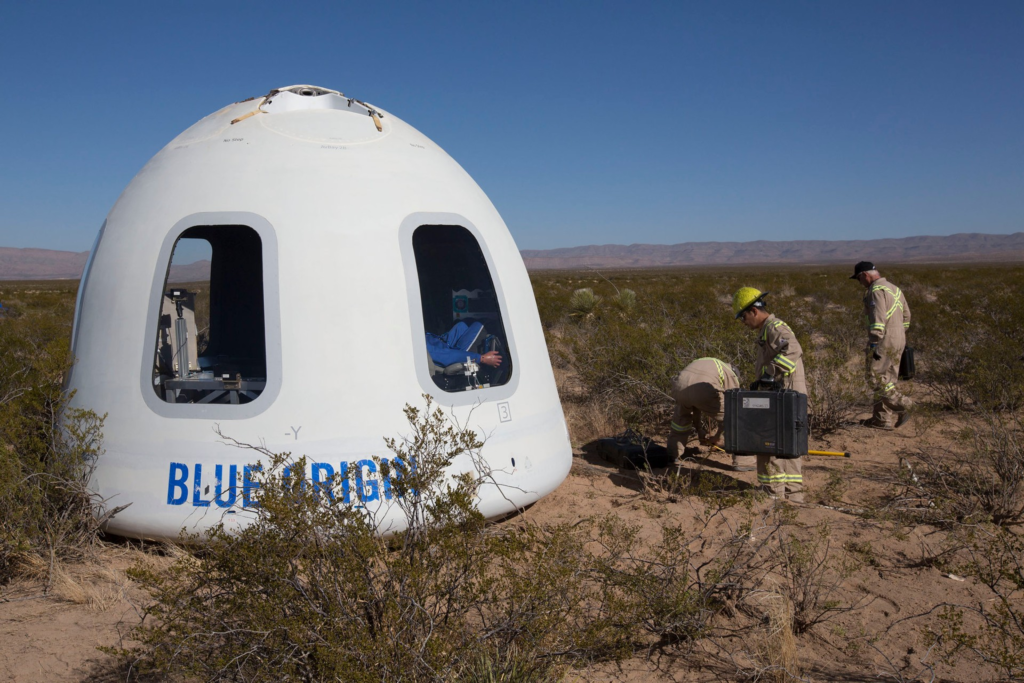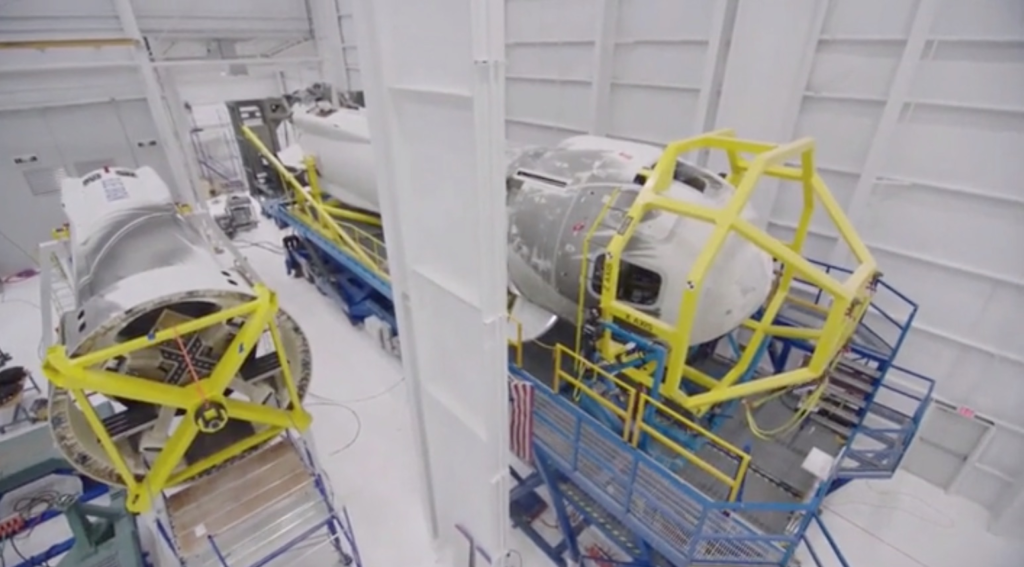
What Happened To Blue Origin’s New Shepard Rocket?
The last time Blue Origin’s New Shepard rocket launched was September 12th, 2022, meaning it has now been over a year since the last flight. The rocket went from launching crew and different payloads every few months to staying grounded. This all has to do with the last flight which suffered an in-flight engine anomaly and the activation of the capsule abort system.
The booster proceeded to crash into the desert floor while the capsule deployed parachutes and landed safely on the ground. Even though there were no crew aboard, New Shepard often does carry humans which caused a large investigation and look into exactly what went wrong. This revealed issues with the main engine and the engine’s nozzle in particular.
Now a full year after this anomaly, the question becomes what does the future look like for this launch vehicle. Here I will go more in-depth into what Blue Origin has been working on, the future of New Shepard, the mishap investigation, and more.
Returning To Flight?

The NS-23 launch appeared to be going normally until about T+1 minutes. The plume from the BE-3 engine that powers the vehicle’s booster changed appearance, and the vehicle then appeared to veer slightly from the vertical. At T+1:05, the capsule’s launch escape motor activated, sending the capsule clear of the booster. The capsule reached a peak altitude of about 11.4 kilometers, then descended, deploying drogue and main parachutes as it would on a normal mission. The capsule touched down near the launch site and the booster crashed into the ground.
About 6 months after this incident Blue Origin released an Investigation report. This report revealed what went wrong and how it led to the destruction of the vehicle. Aided by onboard video and telemetry, flight hardware recovered from the field, and the work of Blue Origin’s materials labs and test facilities, the Mishap Investigation Team determined the direct cause of the mishap to be a structural fatigue failure of the BE-3PM engine nozzle during powered flight. The structural fatigue was caused by operational temperatures that exceeded the expected and analyzed values of the nozzle material. It’s important to point out that while the investigation didn’t explicitly say so, it suggested that at some point in the flight campaign of this booster, design changes were made that allowed for these hotter temperatures to be present.
In terms of future launches, we have heard a few different things from Blue Origin officials. For example, a few months ago, speaking at the Financial Times’ “Investing in Space” event on June 6, Blue Origin Chief Executive Bob Smith said the company was on the verge of resuming New Shepard launches, pending approval from the Federal Aviation Administration. “We knew very soon after the event what exactly happened,” Smith said, saying that the company has been “working through with the FAA on the process by which we go back to flight.”
Looking even further back around 6 months ago in March, the company said they expected flights to resume soon. This being said, Smith continued by pointing out, “We’re now dotting the i’s and crossing the t’s to get through that, as well as getting our system ready to go fly again. New Shepard, from that standpoint, should be ready to go fly within the next few weeks” he said.
The most up-to-date company plans first call for an uncrewed test flight to occur in early October. If all goes well, Blue Origin is then planning its first crewed mission since August 4, 2022, to take place in mid-February of next year. In other words, it will be another 5 months or so before we can expect New Shepard to launch crew.
Another problem that Blue Origin is dealing with is the loss of one of its New Shepard boosters. Over the lifetime of New Shepard, there have been multiple different boosters some more advanced than others. The first booster was lost during a flight in 2015 and the second booster retired in 2016. The third booster was the one used during the NS-23 mission in September and after its crash is no longer available. The only other booster the company has access to is Booster 4. The company is also developing another more advanced booster which improves on the past models and especially what was learned during the previous mishap.
Future Challenges

Despite the launch failure, Blue Origin is not only planning on more future uncrewed and crewed launches but quite a few of them. Earlier this year, Ariane Cornell, vice president of commercial orbit, astronaut, and international sales at Blue Origin commented, “We are still closing out the investigation. We’re working very closely with the FAA. We’re going into very deep, deep detail on that.” She also said that the company was planning to return New Shepard to flight “by the end of this year,” but was not more specific. She noted that the escape system on the vehicle worked “perfectly” on NS-23, a point the company emphasized in its statement about the investigation. In addition, Cornell noted the company had not lost any customers for its crewed flights since the mishap. “Demand continues to be strong,” she said. “We continue to have customers signing up for New Shepard. Some of those even asked to fly an ‘escape’ mission because it seemed so exciting. We have politely declined.”
Other recent comments from Gary Lai, the chief architect for New Shepard, also give us a better idea of New Shepard’s future. In one quote he said, “We expect that in the near future, the coming year, suborbital tourism will dominate our flights,” predicting that Blue Origin will support “about a couple” dedicated payload missions a year, the same as it has, even as the number of private astronaut flights grows.
In an earlier announcement, Blue Origin said that it had begun implementing some corrective actions, “including design changes to the combustion chamber and operating parameters, which have reduced engine nozzle bulk and hot-streak temperatures.” The company also stressed that it expected to return to flight “soon,” with a re-launch of those same 36 research payloads.
While the company seems to be very confident in an increase in demand especially for crew launches, their competitors are making impressive progress. In the time that New Shepard has been grounded, Virgin Galactic a big competitor of Blue Origin in the suborbital space tourism business, has launched four passenger missions with its VSS Unity space plane. Arguably more important than that, the company is expected to increase this launch cadence as well.
Recently, Mike Moses, Virgin Galactic chief of operations and president, when asked by Ars Technica how they plan to fly this vehicle on a weekly basis said “The maintenance. Right now, on Unity, if I need to do some inspections behind the main oxidizer access panel, it’s a big giant panel that’s got 35 fasteners, which sometimes get stripped and then have to be replaced. It’s very labor intensive because it wasn’t built for this. On an airplane, there would be three quick-turn fasteners. A panel comes off, and it goes right back on again.
Delta is going to have that stuff built in. The ships also have critical joints. Unity is glued together; it has bonded joints. On Delta, we’ll have them fastened with fasteners. Again, from an inspection perspective, I don’t have to go bring an X-ray scanner in and determine the health of the glue joint. I have fasteners that have life on them, and I just have to know when I need to check them. It’s much faster, and that’s what gives us the confidence in the weekly turn rates for Delta.
If you apply that to Unity, we’d be able to turn it weekly as well. With the ship itself, things like loading a rocket motor or mating it to the Mothership—all that stuff supports a three-day turn even on Unity. It’s the fact that I have to go inspect bonded joints in the wings that takes time. Somebody has to physically go in [and] bring an ultrasound scanner or an X-ray machine. We don’t have to do it every flight, but we do it a lot. It’s our fleet leader, and we want to be looking at it” he said.
Launching humans into suborbital space that frequently would be a big change within the industry and put more pressure on Blue Origin’s New Shepard option. After New Shepard’s recent mishap, forensic evaluation of the recovered nozzle fragments also showed clear evidence of thermal damage and hot streaks resulting from increased operating temperatures. The fatigue location on the flight nozzle is aligned with a persistent hot streak identified during the investigation. The teams determined that design changes made to the engine’s boundary layer cooling system accounted for an increase in nozzle heating and explained the hot streaks present.
As for the future, Blue Origin is implementing corrective actions, including design changes to the combustion chamber and operating parameters, which have reduced engine nozzle bulk and hot-streak temperatures. Additional design changes to the nozzle have improved structural performance under thermal and dynamic loads. The first test of these changes should be just next month on an uncrewed flight. Assuming it goes well, the company plans to ramp up crewed flights similar to Virgin Galactic. On the other hand, if a problem were to occur, it would have serious implications for the New Shepard program. This could halt future launches in general and most definitely crewed launches as well. Something we will have to wait and see in the coming months.
Conclusion
Blue Origin hasn’t flown its New Shepard vehicle in over a year now. After the last flight, the company worked to figure out exactly what went wrong and make sure it never happens again. This has also given their competitor a lot of time to fly and develop the Unity and Delta systems. We will have to wait and see how it progresses and the impact it has on the space industry.